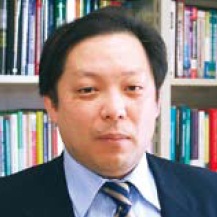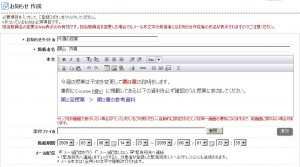03-03. Quizzes with Explanatory Comments Dramatically Improved Review Benefits
Masanori Yokoyama
Professor, Faculty of Commerce
Professor Yokoyama has incorporated Course N@vi into his courses since the 2007 fall semester. He has found Course N@vi useful not only as a tool for bidirectional communications with students — using the information article function for sending bulk emails and review sheets to collect student impressions on classes — but also for dramatically raising learning outcomes by using the quiz function to encourage students to review.
Examination results improved after holding quizzes
Professor Yokoyama had never really been interested in computers until, in his former position as Associate Dean of Academic Affairs, he saw the e-learning efforts of the Distance Education Program (e-School) at the School of Human Sciences. This experience got him interested in applying new information technology to education.
The first thing the professor tried when Course N@vi was introduced in the fall of 2007 was the information article function. He quickly discovered after using the function to inform students of sudden classroom changes or submission deadlines for reports that it was extremely useful as a means of ensuring the information he wanted conveyed reached all students, even absent students. “When I suddenly came down with a 39°C fever, first thing in the morning I was able to inform not just my office but all my students that classes would be canceled.”
The information article function proved useful during his extended leaves as well for giving instructions on seminar training camps or assigning readings. The Course N@vi information article function is now an essential part of all his courses.
The following year the professor began using the quiz function in his lecture subjects. He designs the quizzes to have 15 to 20 questions, each taking about one to two minutes to solve, so the quizzes can be completed in under 30 minutes. He holds the quizzes at a rate of about one every two to three classes. The quizzes require students either to choose the correct sentence from a number of sentences or to write in how many of the sentences are correct. When a quiz is over, Professor Yokoyama uploads the marks along with the correct answer and an explanation for each question. “By repeating these quizzes, I can set questions that cover a lot of ground in a very detailed fashion. It has a very great review benefit for students because they can check the answers as many times as they like after the quiz is over.”
Holding quizzes led to around a three-point improvement in the average score on in-class examinations out of 50 points even though the problems were no more or less difficult than in other years.
Professor Yokoyama had held quizzes prior to Course N@vi’s introduction, but he claims there has been a big difference in the results. “There wasn’t enough time in class to go over the quizzes, so the students wrote the quizzes and left. With Course N@vi, however, the students can check their marks and the explanations on the computer screen, so they can verify what they got right and where they went wrong.”
When he first started using Course N@vi, the quizzes themselves were done in the classroom and the explanations distributed after the quiz with the information article function. “But using the Course N@vi quiz function for both setting and answering quizzes means the students can refer to the explanation right on the same screen.”
The professor not only hears from students about their satisfaction with having done a thorough review; he has noticed they have a greater sense of participation in the class. “There has been a transformation where the former passive attitude toward classes is disappearing because we have created an environment where the students have to continue studying outside of class instead of just showing up at class and listening to me lecture.”
Professor Yokoyama has found that students who actively participate in Course N@vi have better examination results and higher pass rates. We can infer that the higher a student’s motivation to study, the more enthusiastically he or she will engage with Course N@vi; it is only natural then, in a certain sense, that this would lead to better examination results. “It is absolutely true that Course N@vi is a remarkably useful tool for motivated students. There are other students who enjoy the online quizzes because they are like a game.”
Macroeconomics and Economic Policies, two 2008 subjects designed around Course N@vi quizzes, had 300 and 100 students respectively. Course N@vi saved time in marking the quizzes and made it possible for the professor to easily confirm the percentage of correct answers for each question. Not only did this give him a perspective on students’ understanding of the material, it acted as a salutary reflection on his teaching methods. “It is appealing to me to gauge each individual’s academic ability, something I couldn’t see before because of the sheer numbers of students. I like to think of it not as one teacher versus 300 students but rather as building 300 pairs of one-to-one relationships.”
Address student’s tiniest wants with review sheets
Another benefit Professor Yokoyama senses is the review sheets on which students write their impressions on and questions about classes. They are useful for communicating with many students, around 50 to 60 in a 300-student class. Not all students fill out review sheets because they are not required to earn marks.
“Especially after a quiz, I get all kinds of comments about the questions, like ‘they were hard’ or ‘I got them easily.’” The professor also gets requests to change quiz dates or to write in a different color on the white board because the current color is hard to see in the light’s reflection.
“These are things I’d never noticed before, but when they are pointed out to me, I’m often able to correct them right away. Being able to flexibly respond to even the most trivial things raises the students’ ambitions and motivates me as well.”
Professor Yokoyama, who says he loves talking with students, makes it a rule to answer every comment. “It seems recent students have an introverted side to them, but exchanging comments through Course N@vi has improved my relationship with them and makes it easier for them to approach me in person as well. It’s a delight for me to know students’ reactions.”
Potential for information in education sensed in on-demand classes
Although not on Course N@vi, Professor Yokoyama did previously record a video lecture for the general public that was posted on the university’s website. He was moved when he received an email from a high-school student in Kagoshima who saw the video and wrote: “I absolutely want to go Waseda’s School of Commerce.”
“I was amazed that someone from so far away saw the video. I realized then that if you could integrate into education this facility of telecommunications, the potential could be completely different from what we’ve had up to now.”
Conventional education has required people to spend the same time in the same place, but we are now in an era where telecommunications can overcome time and space boundaries and unite education. “I think we should try to carefully combine those aspects that must be done in person and those aspects that can be done online.”
At the present time, however, the professor is not considering incorporating on-demand classes into his normal classes. “I don’t have time to prepare an on-demand class in case of a sudden class cancelation, so I will deal with those situations by setting a quiz.”
There is one Course N@vi function that has not gone over very well. When seminar leaders have tried to guide a debate with the discussion function, the students have reacted negatively: “It’s difficult to have a debate because you are so distant from the others. I want to see the others’ face in a discussion.” Because of this reaction, in seminar classes, Course N@vi is used only for the information article function and for posting materials.
Professor Yokoyama has not used Course N@vi’s submission function for reports either because it is simpler to read reports on paper than on a screen and brief comments can be written more easily on paper. “Depending on the nature of the subject, there are some Course N@vi functions that are suitable and some that are not. I think each faculty member should introduce them as they feel fit.”
The professor has suggested using Course N@vi in the future not just at the university but also at affiliated schools. “I think Course N@vi can be well utilized in pre-admission education; for example, having high-school students submit reports through Course N@vi.”
Academic Advising Office will answer your questions
Not many of Professor Yokoyama’s colleagues have taken up Course N@vi. “Nevertheless, I often see them submit their grades on Course N@vi. It’s particularly handy for part-timers because it saves them from having to come all the way to the university.”
“It certainly does take time and energy to create quizzes and reply to comments. But I don’t find it a bother if I know that students are getting better learning outcomes as a result. The system itself isn’t particularly difficult to use even if you aren’t that knowledgeable about computers.”
When he does have a question, Professor Yokoyama turns to the Academic Advising Office. “In fact, students use the Academic Advising Office too.”
There are some who marvel at Professor Yokoyama, who used to avoid even email in the past, when they see him using Course N@vi so diligently. It’s because he’s personally experienced the many benefits that he recommends his colleagues to actively employ Course N@vi. “Course N@vi should definitely be used effectively as a means of improving learning outcomes.”
At seminars for new teaching staff, the hottest topic turns out to be Course N@vi. “As its features get richer over time, there will be more applications for it. And I expect as more faculty members incorporate it and Course N@vi usage becomes a given, it will become only easier to use.”
Tips on implementing Course N@vi
“The information article function is incredibly useful because information will reach all students equitably. It’s simple to use, so I encourage everyone to try it.”
<Announcement function>
Checking the “Contact the emergency address” option for urgent messages, such as a same-day class cancelation, will deliver the message to mobile phone addresses, etc. that students have preset as their emergency contact.



